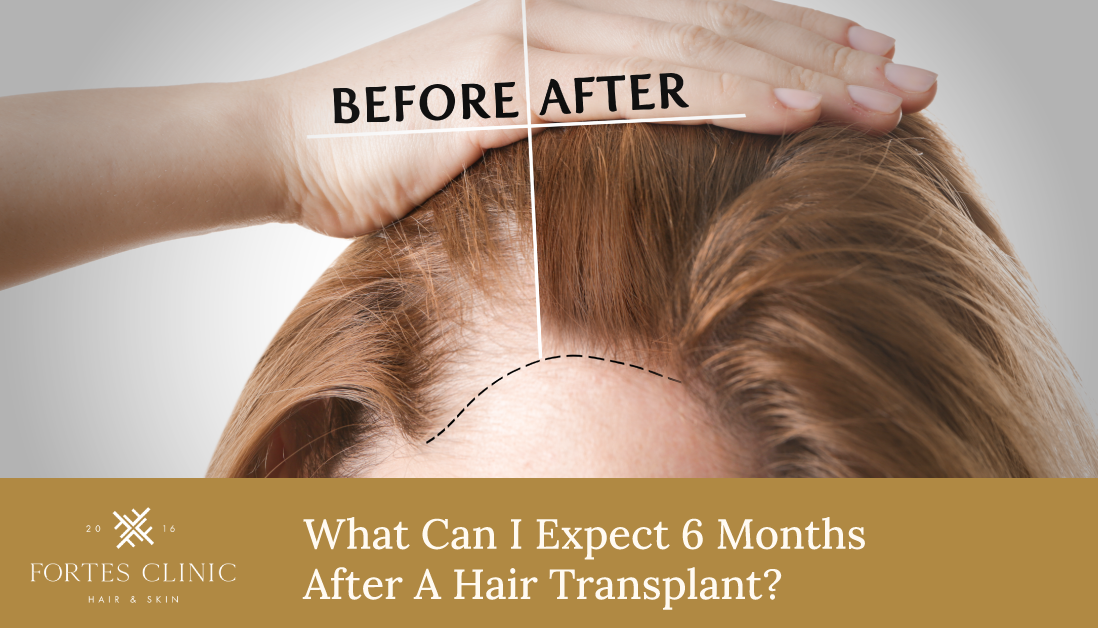Introduction
Many patients want to know what to expect 6 months after a hair transplant. By this point, you are well past the early healing phase, but you are not yet at the finish line. This guide sets out the typical progress at month six, why density is still building, what counts as normal variation, and when to seek advice. For background on techniques and recovery, see the NHS overview of hair transplants.
The Road to Month Six: A Quick Recap
Understanding how you got here helps set expectations.
- Weeks 0 to 2: Tiny scabs form around grafts, and redness settles. Careful washing and sleeping guidance apply.
- Weeks 2 to 6: Temporary shedding of transplanted hairs is common, often called shock loss.
- Months 3 to 4: Early regrowth begins. New hairs look fine and soft at first.
- Month 5: Many people notice the first meaningful cosmetic change.
For a fuller step-by-step overview, see the hair transplant recovery timeline.
What to Expect 6 Months After a Hair Transplant
At the six-month mark, most patients can see clear progress, though final results are still developing.
Visible growth and early thickening
New hairs are usually present across the transplanted area. They are often thinner than your native hair, with a texture that can feel slightly wiry or fluffy. This is normal. Thickness and calibre improve over the coming months as the hairs cycle and mature.
Improving hairline definition
A newly created hairline often reads well at six months, especially after FUE hair transplant. Fine micro hairs at the front begin to blend with stronger grafts behind. If you had a larger session, the outline should look increasingly natural.
Crown catches up later
Crown work tends to develop more slowly than the frontal third. At six months, coverage may look lighter at the crown compared with the hairline. This usually improves between months nine and twelve.
Density is not final
Even with strong early growth, density at six months is only part of the story. Many patients see the biggest cosmetic jump between months six and ten as more follicles exit dormancy and shafts thicken.
Colour and texture changes
New hair can appear slightly lighter or have a different texture at first. As the hair shaft matures, colour depth and texture tend to align more closely with surrounding hair.
Why Results Vary at Six Months
No two results look identical at this stage. Variation comes from:
- Technique and graft numbers. Larger sessions, or combinations of FUE and FUT, may take longer to show uniform density.
- Area treated. Frontal work often appears to progress faster than crown work.
- Hair characteristics. Coarse, curly or light coloured hair can give the appearance of more coverage than fine, straight or very dark hair on pale scalps.
- Aftercare and health. Consistent washing technique, sun protection and general health all support growth.
Styling and Day-to-Day Care at Month Six
By month six, most people have returned to normal routines. A few practical tips help support results.
- Gentle products. Use a mild shampoo and avoid heavy product buildup that can weigh down early regrowth.
- Heat and tools. Moderate heat is usually fine, but keep temperatures sensible and avoid prolonged, direct heat on one spot.
- Haircuts. Trims are generally fine now. Ask your barber to work carefully around any areas that still feel sensitive.
- Sun exposure. Protect the scalp with shade or sunscreen when outdoors for extended periods. Guidance can differ by patient, so follow your post op instructions.
If you are unsure about headwear timing, this guide answers common questions: how long after a hair transplant can I wear a hat?
Supportive Options Between Months Six and Twelve
Some patients choose medical or clinic-based treatments to complement surgical work.
- Medication. A tailored plan may include topical finasteride or minoxidil, depending on suitability.
- Clinic therapies. Options such as PRP are sometimes used to support hair quality.
- Density planning. If native hair continues to thin, a staged approach can be discussed during review appointments.
Any add-on should be considered in the context of your medical history and goals. If you are weighing options, send a message or book through the contact page.
When to Seek Advice
Some worries at month six are common and not usually a cause for concern. Others merit a check-in.
Usually normal
- Growth that looks uneven, with certain patches ahead of others.
- Hairs that feel thin, wiry or lighter in colour.
- A crown that seems to be lagging behind the hairline.
Worth asking about
- Persistent redness or irritation that is not settling.
- Localised areas with no visible sprouting at all if the surrounding area has grown well.
- Sudden shedding of transplanted hairs after they have started to grow.
- Any pain, swelling or symptoms that feel out of the ordinary.
A short review can reassure you or identify simple measures that help.
Expectations for Months Nine to Twelve
The final quarter is where many patients see the biggest confidence boost.
- More follicles come through. Areas that looked thin at six months often fill in.
- Shafts thicken. As new hairs cycle, the calibre increases, improving coverage and texture.
- Styling improves. By twelve months, most people can style hair in line with their goals. Some complex cases, or crown-focused work, can continue to improve up to eighteen months.
Common Questions at the Six-Month Mark
Is six months enough time to judge the result?
Not fully. You should see meaningful change, but the picture is still developing. Most results mature between months nine and twelve.
What if the result looks patchy?
Patching at six months is common and not predictive of the final outcome. Density often evens out as more grafts exit dormancy.
Could I need a second procedure?
Some plans are staged by design, especially with advanced thinning. If more density is desired once growth has matured, options can be discussed at a review.
Does the technique change how month six looks?
Both FUE and FUT can produce excellent outcomes. FUE often blends quickly at the hairline, while large FUT sessions can deliver strong density once matured.
Key Takeaways 6 Months After a Hair Transplant
- You should see obvious progress by month six, but density is not final.
- Hairline definition is usually encouraging at this stage, but the crown often lags.
- Texture and colour differences are normal early on and tend to settle.
- Good habits, patience and follow-up reviews make a real difference.
- If in doubt, ask for advice rather than worrying in silence.
Next Steps
If you are six months in and want tailored guidance, arrange a quick review or send photos through the contact page. If you are still researching the journey, the full recovery timeline is a helpful reference.



